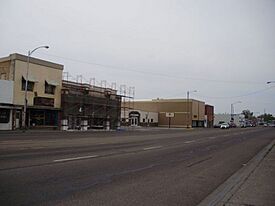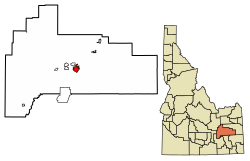Blackfoot, Idaho facts for kids
Quick facts for kids
Blackfoot
|
||
|---|---|---|

Business District of Blackfoot
|
||
|
||

Location of Blackfoot in Bingham County, Idaho
|
||
| Country | United States | |
| State | Idaho | |
| County | Bingham | |
| Founded | 1878 | |
| Incorporated | 1907 | |
| Area | ||
| • City | 6.21 sq mi (16.08 km2) | |
| • Land | 5.92 sq mi (15.34 km2) | |
| • Water | 0.28 sq mi (0.74 km2) | |
| Elevation | 4,502 ft (1,372 m) | |
| Population
(2020)
|
||
| • City | 12,346 | |
| • Estimate
(2022)
|
12,702 | |
| • Density | 2,084.1/sq mi (804.7/km2) | |
| • Urban | 14,231 | |
| • Metro | 49,923 (US: 217th) | |
| • Combined | 284,485 (US: 121st) | |
| Time zone | UTC–7 (Mountain (MST)) | |
| • Summer (DST) | UTC–6 (MDT) | |
| ZIP Code |
83221
|
|
| Area code(s) | 208 and 986 | |
| FIPS code | 16-07840 | |
| GNIS feature ID | 2409857 | |
Blackfoot is a city in Idaho, United States. It is the main city of Bingham County. In 2020, about 12,346 people lived there. Blackfoot is also known as the "Potato Capital of the World" because of its large potato industry.
Contents
History of Blackfoot
Blackfoot is located in the middle of Bingham County. It sits on the south side of the Snake River. The city became the county seat (the main town for the county's government) on January 13, 1885.
Before Blackfoot, another town called Eagle Rock (now Idaho Falls) was supposed to be the county seat. But after some political discussions, Blackfoot was chosen instead.
The first permanent white settlers in this area were Frederick S. Stevens and Joe Warren in 1866. They started farming and ranching near where Blackfoot is today. The area was a flat plain covered in sagebrush. When the Utah and Northern Railway expanded into Idaho in the 1870s, settlers planned a town. They named it Blackfoot, a name fur traders had used for the area.
William Edward Wheeler started the Blackfoot Register newspaper on July 1, 1880. The first newspaper issue described the businesses in Blackfoot. These included stores, a hotel, saloons, and a lumber yard. Henry W. Curtis opened the first hardware store in 1885.
The newspaper also mentioned a plan to bring water from the Blackfoot River to the town. This water would help residents grow gardens and plant trees. In 1886, Alfred Moyes planted the first shade trees around the Blackfoot Courthouse. Soon, Blackfoot became known as "Grove City" because of its many tree-lined streets. People would visit just to see the green trees in contrast to the dry sagebrush plains.
Geography and Climate
Blackfoot covers about 6.07 square miles (15.72 square kilometers). Most of this area is land, with a small part being water.
The city has a semi-arid climate. This means it has cold winters and hot summers.
| Climate data for Blackfoot, Idaho, 1991–2020 normals, extremes 1895–present | |||||||||||||
|---|---|---|---|---|---|---|---|---|---|---|---|---|---|
| Month | Jan | Feb | Mar | Apr | May | Jun | Jul | Aug | Sep | Oct | Nov | Dec | Year |
| Record high °F (°C) | 60 (16) |
74 (23) |
79 (26) |
88 (31) |
96 (36) |
108 (42) |
104 (40) |
104 (40) |
99 (37) |
88 (31) |
74 (23) |
61 (16) |
108 (42) |
| Mean maximum °F (°C) | 44.7 (7.1) |
50.4 (10.2) |
64.6 (18.1) |
75.7 (24.3) |
84.2 (29.0) |
91.1 (32.8) |
96.5 (35.8) |
95.4 (35.2) |
89.3 (31.8) |
78.1 (25.6) |
62.6 (17.0) |
49.3 (9.6) |
97.5 (36.4) |
| Mean daily maximum °F (°C) | 31.2 (−0.4) |
37.0 (2.8) |
48.8 (9.3) |
57.4 (14.1) |
67.6 (19.8) |
76.7 (24.8) |
86.9 (30.5) |
85.9 (29.9) |
75.1 (23.9) |
60.5 (15.8) |
44.8 (7.1) |
32.1 (0.1) |
58.7 (14.8) |
| Daily mean °F (°C) | 24.0 (−4.4) |
28.8 (−1.8) |
39.0 (3.9) |
46.1 (7.8) |
55.2 (12.9) |
63.2 (17.3) |
71.4 (21.9) |
70.1 (21.2) |
60.6 (15.9) |
47.8 (8.8) |
35.1 (1.7) |
24.8 (−4.0) |
47.2 (8.4) |
| Mean daily minimum °F (°C) | 16.8 (−8.4) |
20.5 (−6.4) |
29.1 (−1.6) |
34.7 (1.5) |
42.8 (6.0) |
49.8 (9.9) |
56.0 (13.3) |
54.2 (12.3) |
46.0 (7.8) |
35.0 (1.7) |
25.5 (−3.6) |
17.5 (−8.1) |
35.7 (2.0) |
| Mean minimum °F (°C) | −3.4 (−19.7) |
1.1 (−17.2) |
14.8 (−9.6) |
21.8 (−5.7) |
29.2 (−1.6) |
36.8 (2.7) |
45.5 (7.5) |
42.2 (5.7) |
32.3 (0.2) |
20.9 (−6.2) |
8.3 (−13.2) |
−2.6 (−19.2) |
−8.3 (−22.4) |
| Record low °F (°C) | −40 (−40) |
−39 (−39) |
−19 (−28) |
6 (−14) |
17 (−8) |
24 (−4) |
30 (−1) |
23 (−5) |
12 (−11) |
−1 (−18) |
−24 (−31) |
−30 (−34) |
−40 (−40) |
| Average precipitation inches (mm) | 0.99 (25) |
0.73 (19) |
1.10 (28) |
1.40 (36) |
1.75 (44) |
1.03 (26) |
0.50 (13) |
0.60 (15) |
0.97 (25) |
1.12 (28) |
0.75 (19) |
1.11 (28) |
12.05 (306) |
| Average snowfall inches (cm) | 6.0 (15) |
2.2 (5.6) |
0.3 (0.76) |
0.7 (1.8) |
0.0 (0.0) |
0.0 (0.0) |
0.0 (0.0) |
0.0 (0.0) |
0.0 (0.0) |
0.8 (2.0) |
1.4 (3.6) |
3.3 (8.4) |
14.7 (37.16) |
| Average precipitation days (≥ 0.01 in) | 7.7 | 6.9 | 6.8 | 8.5 | 8.1 | 5.8 | 3.3 | 3.3 | 4.3 | 5.9 | 5.1 | 7.8 | 73.5 |
| Average snowy days (≥ 0.1 in) | 2.6 | 2.2 | 0.5 | 0.3 | 0.0 | 0.0 | 0.0 | 0.0 | 0.0 | 0.3 | 1.1 | 3.7 | 10.7 |
| Source 1: NOAA | |||||||||||||
| Source 2: National Weather Service | |||||||||||||
Population and People
| Historical population | |||
|---|---|---|---|
| Census | Pop. | %± | |
| 1880 | 285 | — | |
| 1890 | 538 | 88.8% | |
| 1900 | 1,000 | 85.9% | |
| 1910 | 2,202 | 120.2% | |
| 1920 | 3,937 | 78.8% | |
| 1930 | 3,199 | −18.7% | |
| 1940 | 3,681 | 15.1% | |
| 1950 | 5,780 | 57.0% | |
| 1960 | 7,378 | 27.6% | |
| 1970 | 8,716 | 18.1% | |
| 1980 | 10,065 | 15.5% | |
| 1990 | 9,646 | −4.2% | |
| 2000 | 10,419 | 8.0% | |
| 2010 | 11,899 | 14.2% | |
| 2020 | 12,346 | 3.8% | |
| 2022 (est.) | 12,702 | 6.7% | |
| Source: U.S. Decennial Census 2020 Census |
|||
2010 Census Details
In 2010, Blackfoot had 11,899 people living there. There were 4,229 households. About 39.3% of these households had children under 18. Most households (51.4%) were married couples.
The people in Blackfoot come from different backgrounds. About 83.1% were White. Other groups included Native American (3.5%), Asian (1.1%), and African American (0.3%). About 18.4% of the population was Hispanic or Latino.
The average age in the city was 30.8 years old. About 31.3% of residents were under 18. About 12.8% were 65 years or older. The population was almost evenly split between males (49.6%) and females (50.4%).
Economy
Blackfoot is famous for its potato industry. It is known as the "Potato Capital of the World." This means it has the largest potato farming and processing in any one area.
Arts and Culture
Blackfoot is home to the Idaho Potato Museum. Here, you can see the world's largest baked potato and potato chip! The city also hosts the Eastern Idaho State Fair. This fair is a big event with rides, food, and entertainment.
Education
Students in Blackfoot attend schools in two main districts. These are the Blackfoot School District #55 and the Snake River School District #52.
High Schools
- Blackfoot High School
- Independence High School
- Snake River High School
- Bingham Academy
Middle Schools
- Mountain View Middle School
- Idaho Science And Technology Charter School
- Snake River Junior High School
- Snake River Middle School
- BCCLC Middle School
Elementary Schools
- Blackfoot Sixth Grade School
- Fort Hall Elementary School
- Groveland Elementary School
- Ridgecrest Elementary School
- Donald D. Stalker Elementary School
- I.T. Stoddard Elementary School
- Wapello Elementary School
- Blackfoot Charter Community Learning Center
- Rockford Elementary
- Moreland Elementary
Notable People
- Kimball Allen, a writer and actor
- Dan Clark, a stand-up comedian and writer
- Josh Hill, a professional football player
- Dixie Kiefer, a U.S. Navy captain during WWII
- Larry Scott, a bodybuilder and the 1966 Mr. Olympia; he was born in Blackfoot
- Mike Simpson, a U.S. Representative from Idaho
See also
 In Spanish: Blackfoot (Idaho) para niños
In Spanish: Blackfoot (Idaho) para niños



